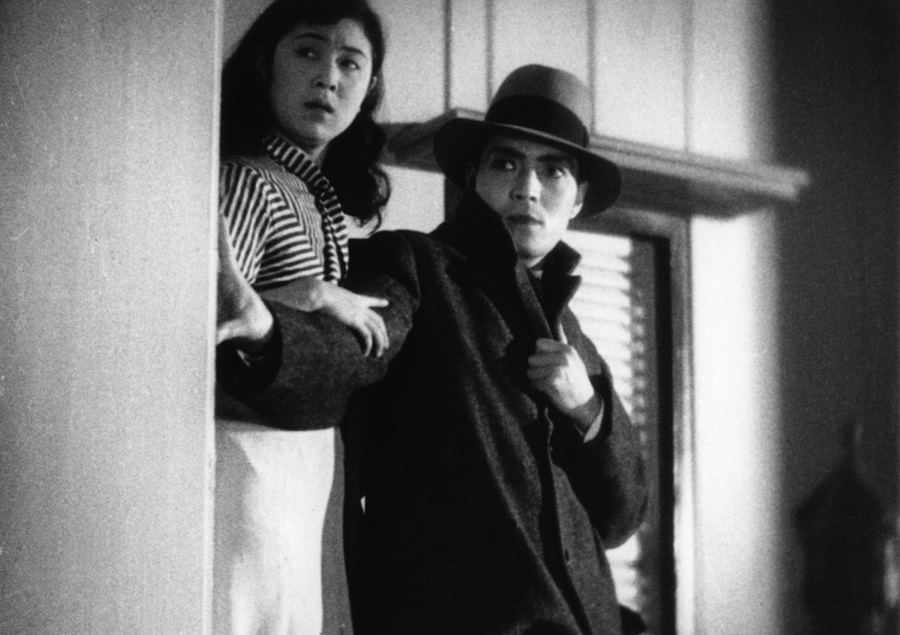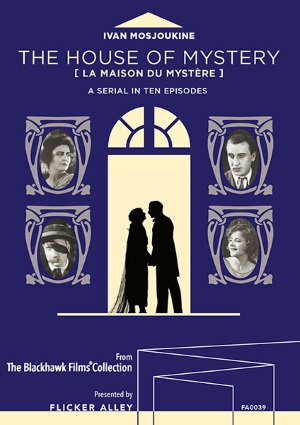 The House of Mystery (La Maison du Mystère) (Flicker Alley, DVD) – Serials—the adventure cliffhangers what would play out in theaters before the main feature at a chapter a week—are commonly dismissed as kid stuff, glorified B-movies cranked out with little thought for story or character. France, however, produced some serials with high production values for adult audiences. Louis Feuillaude was a master at making surreal pulp thrillers like Fantomas and Les Vampires but Judex moved him toward epic storytelling with more mature themes (his later serials, which are even more adult if less exciting, are sadly unavailable in the U.S.).
The House of Mystery (La Maison du Mystère) (Flicker Alley, DVD) – Serials—the adventure cliffhangers what would play out in theaters before the main feature at a chapter a week—are commonly dismissed as kid stuff, glorified B-movies cranked out with little thought for story or character. France, however, produced some serials with high production values for adult audiences. Louis Feuillaude was a master at making surreal pulp thrillers like Fantomas and Les Vampires but Judex moved him toward epic storytelling with more mature themes (his later serials, which are even more adult if less exciting, are sadly unavailable in the U.S.).
Albatross, a French studio founded by Russian immigrants who fled the communist revolution, produced some of the most sophisticated films on the twenties, including the serial The House of Mystery (1923), an epic story of love, jealousy, murder, blackmail, and injustice. The opening credits tease the audience by presenting our hero in multiple disguises before revealing the face of Ivan Mosjoukine, suggesting he is something of a Judex or Fantomas. In fact he’s Julien Villandrit, the scion of a manufacturing family who marries his sweetheart Régine (Hélène Darly) and takes over the family textile mill. All seems well as we jump to “Seven Years Later” and find his longtime associate Henri (Charles Vanel) going all Iago, planting the seeds of doubt in Julien’s mind over the attentions of an elderly banker (Sylvia Gray) toward his wife. What seems unseemly has a rather touching explanation but it takes a dramatic turn when Julien is framed for murder and sent to prison while Henri remains free to pursue Régine. Nicolas Koline plays the woodsman Rudeberg, a photographer whose hobby gives him the leverage to blackmail his way into a steady job. It’s not quite as mercenary as it seems—it’s all to give his troubled son a shot at an education and a better life than him—but it means hiding the evidence proving Julien’s innocence and incriminating the true killer.
Over the course of a story that spans decades there is a daring jailbreak and desperate escape over rugged mountains and deadly ravines (it takes up almost an entire chapter and is a magnificent piece of silent action spectacle), and a series of disguises donned by our hero to return home and clear his name, but this is more romantic melodrama than thriller. A wedding scene is played in a series of silhouettes that resembles the delicacy of the cut-out animation of Lotte Reiniger and the trial sequence takes a break from courtroom drama for a lovely moment of silent movie connection as Régine nudges Julien to sit up, refresh himself, and reclaim his dignity, all communicated in gestures and glances across the room.
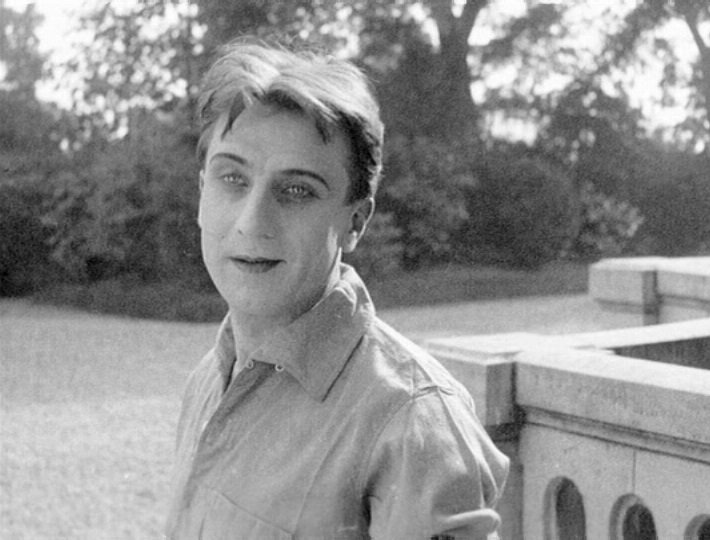
Ivan Mosjoukine
Mosjoukine is magnificent in the leading role, a part in which he invested himself completely. He transforms from nervous, unworldly, odd young man to confident husband and father to tragic hero who spends years attempting to reunite with his family, and that doesn’t include the characters he creates while hiding out from the authorities. Mosjoukine wrote the adaptation (it was based on a bestselling novel) and even created his own make-up, and his transformation is as complete (if not quite as extreme) as Lon Chaney in the states.
It plays like a modern TV mini-series, more concerned with dramatic complications and character conflict than with action-film cliffhangers. The serial format gives the drama room to breathe and the actors space to develop characters and relationships over 10 chapters and 6 ½ hours and Alexandre Volkoff directs with a high degree of sophistication and elegance. It’s what silent cinema does at its best: delve into the depth of the moment, drawing out action to explore the dramatic textures and letting the actors reveal the emotions of the characters, to show the audience rather than explain in intertitles. That sounds like a hard sell to viewers not already enchanted by the charms of silent cinema but this is a lovely film and a superb presentation of a rarity. It could make a convert of anyone with a love of classic movies and cinema history.
The complete serial was restored in 1992 and was digitally remastered for its home video debut by Eric Lange and Lobster Films in 2014, and it features a piano score by Neil Brand. Also includes a gallery of production stills and a booklet with an essay and notes on the film and the filmmakers by silent film historian Lenny Borger.
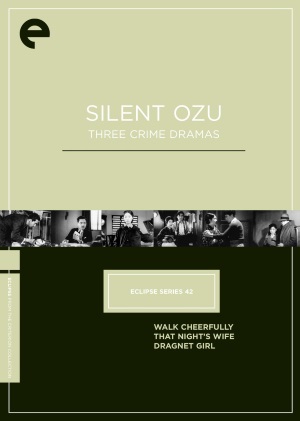 Silent Ozu – Three Crime Dramas (Eclipse 42) (Criterion, DVD) is an apt companion piece to Criterion’s previous set of silent Yasujiro Ozu films on their Eclipse line. The artist called the most “Japanese” of Japanese directors, famous for the quiet restraint and rigorous simplicity of his sound films, was a voracious film buff more interested in Hollywood movies than his own national cinema early in his career and he thrived in a great variety of genres. The previous Eclipse set collected a trio of family comedies. This one offers three gangster films: Ozu noir, so to speak, inspired by the late silent crime pictures by Josef von Sternberg and American pictures. These films are more intimate character pieces than the gangster romantic tragedies of their American cousins, but they are lively productions directed with a dynamic style he stripped away through the 1930s.
Silent Ozu – Three Crime Dramas (Eclipse 42) (Criterion, DVD) is an apt companion piece to Criterion’s previous set of silent Yasujiro Ozu films on their Eclipse line. The artist called the most “Japanese” of Japanese directors, famous for the quiet restraint and rigorous simplicity of his sound films, was a voracious film buff more interested in Hollywood movies than his own national cinema early in his career and he thrived in a great variety of genres. The previous Eclipse set collected a trio of family comedies. This one offers three gangster films: Ozu noir, so to speak, inspired by the late silent crime pictures by Josef von Sternberg and American pictures. These films are more intimate character pieces than the gangster romantic tragedies of their American cousins, but they are lively productions directed with a dynamic style he stripped away through the 1930s.
Walk Cheerfully (1930) mixes the gangster drama with character comedy in the story of a hood named Ken the Knife (Minoru Takada) who vows to go straight when he falls in love with a “good” girl. His old girlfriend, who sports a Louise Brooks bob, isn’t happy about being dumped and decides to get revenge on them both. In fact, there’s a lot of American influence in the film, from the storytelling to the camerawork (from tracking shots to oblique, dramatic camera angles) to fashions; these hoods are as sporty as their Hollywood counterparts with their flashy suits and fedoras and swaggering attitudes. This is a bright picture, as the title suggests. The mob isn’t happy that Ken and his partner (Hisao Yoshitani) have left the gang but for all the obstacles, this is on the more lighthearted side of the gangster genre.
More somber is That Night’s Wife (1930), which opens on the robbery of an office building by a lone gunman (Tokihiko Okada), a marvelous scene that is a model of crime movie direction, before revealing that the thief is no career criminal but a desperate father whose daughter is on the verge of death. The money is for the medicine that may save her life. Most of the film takes place in the one-room family home as the father and mother stand vigil over their young daughter, holding a cop hostage as they wait for her recovery. It’s a standoff with a poignant twist and Ozu orchestrates the situation beautifully with expressive camerawork and tight editing. This was shot and set in the depths of Japan’s depression. Ozu explored the plight of middle and working class families slipping into poverty and desperation in other films as well (see Tokyo Chorus in Silent Ozu: Three Comedies) but this is his most moving portrait.
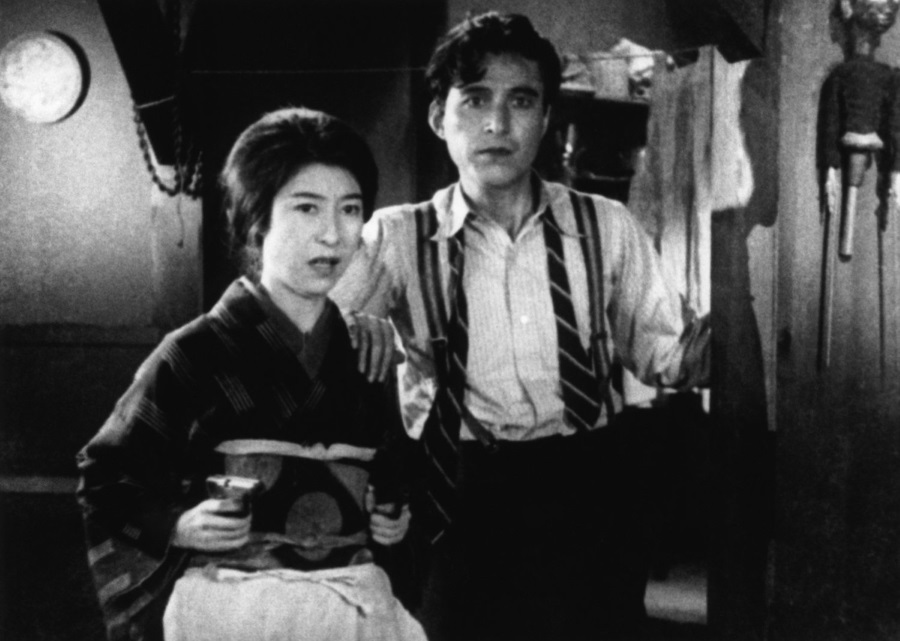
‘That Night’s Wife’
Dragnet Girl (1933) is the most flamboyant of the three, a redemption tale not of the gangster (Joji Oka) but his moll Tokiko (Kinuyo Tanaka), who has a civilian job by day and plays in the criminal underworld by night. When her boyfriend is smitten by the good girl sister of a young boxer, she ends up befriending the girl and deciding to go straight herself. Except that he wants her to pull one last job. This was made after the explosion of Hollywood gangster movies in the early sound era and Ozu livens the story with fluid tracking shots, snappy editing, and striking compositions and editing. And he makes Tokiko a real tough cookie and a tough-love idealist, with a novel way of convincing her boyfriend to go straight.
Japanese intertitles with English subtitles. These are preserved rather than restored films, mastered from prints that are scuffed and damaged in places, but they are stable and well mastered from the existing element and feature fine piano scores by Neil Brand. As with all Eclipse releases, there are no supplements. Each film is in its own slimline case with an essay by house writer Michael Koresky.
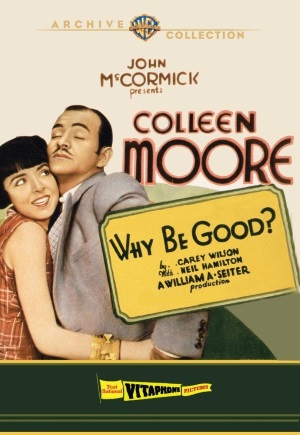 Why Be Good? (Warner Archive, DVD) – Colleen Moore was, along with Clara Bow, one of the defining screen incarnations of the flapper in the silent era: cute, vivacious, flirtatious, and fun loving. But where Bow had a sly, bad-girl impishness and a carefree sexuality, Moore was a good girl who just liked to have fun. Why Be Good? (1929) puts that dichotomy at the center of the story.
Why Be Good? (Warner Archive, DVD) – Colleen Moore was, along with Clara Bow, one of the defining screen incarnations of the flapper in the silent era: cute, vivacious, flirtatious, and fun loving. But where Bow had a sly, bad-girl impishness and a carefree sexuality, Moore was a good girl who just liked to have fun. Why Be Good? (1929) puts that dichotomy at the center of the story.
Moore is a salesgirl at a department store who dances up a storm and plays the sassy, high-spirited life of the party by night, a wild child in short skirts who nonetheless shuns liquor and guards her virtue. She understands all too well the double standard applied to women: men like to have fun but they settle down with proper girls. She’s determined to be both and stands up to her father’s unfounded judgments with a very modern attitude: “I’m contributing as much to this household as you are,” she reminds him. The story turns on a romance with a young man (played by Neil Hamilton, famed as Commissioner Gordon on the 1960s Batman TV series) who turns out to be the boss’s son, who also calls her virtue into question. It’s a lightweight film with a bubbly energy and some lovely silent movie moments, and an entertaining time capsule of the jazz era that takes on the sexual double standard and presents a woman who demands the same agency as men.
Made during the transition between silent movies and soundies, it was shot as a silent film but released with a synchronized Vitaphone soundtrack of music and sound effects and it features a number of upbeat vocal numbers from the period.
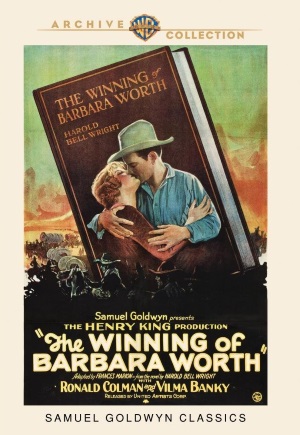 The Winning of Barbara Worth (Warner Archive, DVD), the 1926 drama of the taming of the plains, is a vehicle for Ronald Colman and Vilma Bánky. He’s Willard Holmes, a spoiled New York engineer hired by a ranching mogul (Charles Lane) to bring water to the desert, and she is Barbara, the adopted daughter of the rancher. Then Gary Cooper, who plays Abe, the modest cowboy and wilderness guide and grew up in love with Barbara, practically steals the film. He is gorgeous and pure, a natural whenever he’s on screen and a contrast to Colman’s traditional theatrical performance.
The Winning of Barbara Worth (Warner Archive, DVD), the 1926 drama of the taming of the plains, is a vehicle for Ronald Colman and Vilma Bánky. He’s Willard Holmes, a spoiled New York engineer hired by a ranching mogul (Charles Lane) to bring water to the desert, and she is Barbara, the adopted daughter of the rancher. Then Gary Cooper, who plays Abe, the modest cowboy and wilderness guide and grew up in love with Barbara, practically steals the film. He is gorgeous and pure, a natural whenever he’s on screen and a contrast to Colman’s traditional theatrical performance.
The story is follows Willard’s evolution from sneering city clicker to ally to the pioneers determined to make an Eden in the desert, and he and Abe team up when Willard’s corrupt partner double-crosses everyone. Henry King, one of Hollywood’s sturdiest storytellers and master craftsmen of the both the silent and sound eras, directs, setting the drama against grand, gorgeous desert locations. There’s a classic race against time (to make payroll to stop a riot) and a terrific flood as the dam is breached and the canals overflow. It’s all done with miniatures, a mix of studio craft and audience suspension of disbelief, an art long gone in the age of CGI. But don’t think of it as naïve. It’s just a different kind of cinema art and it’s a delight to see.
Previously available solely in a Gary Cooper set, it’s now available on Warner Archive. The print is in fine condition and is tinted, yellow for the desert by day and blue for night, and the original score plays up the sentiment and sense of grandiosity.
Calendar of upcoming releases on Blu-ray, DVD, Digital, and VOD

